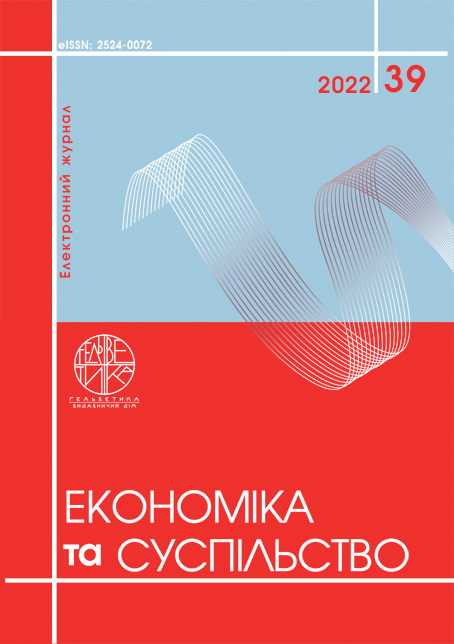STATUS AND FEATURES OF CONCENTRATION RESEARCH IN THE MEDIA INDUSTRY
Abstract
Concentration in the media industry is characterized as a complex dynamic phenomenon. Concentration usually leads to distortion of competition and oppression of the rights of other market participants. However, in the media industry, the consequence of concentration is also the limitation of pluralism, the strengthening of self-censorship, the growth of political power, the weakening of public control and the deterioration of the business climate. If the financial dependence of the media on the owner increases, this leads to a decrease in the competitiveness of the media enterprise. In the conditions of the war in Ukraine, significant problems of all types of media are the limitation of resource capabilities and a decrease in commercial income, which can lead to an increase in the influence of owners or sponsors. Therefore, the issue of media concentration, its diagnosis and the formation of effective measures of legal regulation are relevant. The purpose of the work is to analyze the modern typology of the concept of "media concentration", approaches and indicators for assessing the degree of concentration, and to identify the problems of such an assessment in the domestic media industry. The methods of analysis and synthesis, classification, systematization and grouping, comparison were used for the research. A typology of media concentration is proposed, which is characterized by the results of the functioning of the main participants in the media environment: ownership, market, audience, journalistic and political concentration. Prerequisites for intensification and slowing down of media concentration processes are revealed. The grouping of indicators and research methods used to evaluate media concentration has been carried out. The problems of research methodology formation in modern conditions are characterized, including the incompleteness of statistical and market data; the specifics of forming an online environment in the media, expanding the list of indicators. The results of the study can be used for the formation of a comprehensive methodology for the study of media concentration and the development of practical measures for the legal regulation of the media industry.
References
Закон України «Про захист економічної конкуренції» від 11.01.2001 № 2210-III. URL: https://bit.ly/3Nraq7E
Manfred Knoche (2021). Media Concentration: A Critical Political Economy Perspective. URL: https://bit.ly/3HXjTm7
Trappel, J., Meier, W. A. (2021). Soaring media ownership concentration: Comparing the effects of digitalisation on media pluralism and diversity. In J. Trappel, & T. Tomaz (Eds.), Success and failure in news media performance: Comparative analysis in the Media for Democracy Monitor, 147–164. DOI: https://doi.org/10.48335/9789188855589-7
Petros Iosifidis. (1997). Methods of measuring media concentration. Media Culture and Society. Vol. 19, 643–663.
Hill, B. C. (2006). Measuring media market diversity: Concentration, importance, and pluralism. Fed. Comm. LJ, 58, 169.
Noam E. (2009) Media Ownership and Concentration in America. New York: Oxford University Press. DOI: https://doi.org/10.1093/acprof:oso/9780195188523.001.0001
Carles Llorens. (2013). Media Concentration. Quaderns del CAC, Issue 16, 45-54. URL: https://bit.ly/3OH0dVy
Methodology for monitoring media concentration and media content diversity. Directorate General of Human Rights and Legal Affairs Council of Europe. Strasbourg, 2009. URL: https://rm.coe.int/1680483b18
David Deacon, James Stanyer (2021). Media diversity and the analysis of qualitative variation. Communication and the public. 6, 19–32. DOI: https://doi.org/10.1177/20570473211006481
Хаб’юк О. Концептуальні основи медіа-економіки : монографія. Львів : ЛНУ імені Івана Франка, 2012.
Сhuzhykov A. Media clustering of EU regional systems. Intelectual Challenges to Economic Globalism: collective monograph. Riga: ISMA, 2020. URL: https://bit.ly/3QR1knz
Любчик К. Л. Корпоративні медіастратегії транснаціональних корпорацій Держава та регіони. Серія : Економіка і підприємництво. 2020. № 1 (112). С. 16–19. DOI: https://doi.org/10.32840/1814-1161/2020-1-2.
Малінін В. С. Монополізація та концентрація ЗМІ. URL: https://bit.ly/3OGR27C
Шендерівська Л. П., Лисенко М. А., Малиш Н. О. Розвиток медіа в контексті корпоратизації. Технологія і техніка друкарства, 2018. № 3(61). С. 46–55. DOI: https://doi.org/10.20535/2077-7264.3(61).2018.154705
Індикатори ризиків плюралізму медіа. URL: https://bit.ly/3A3XZeV
Методологія оцінки прозорості регіональних медіа. URL: https://bit.ly/3bxq2cd.
Монополії у сфері масової інформації: законодавче регулювання і деякі вітчизняні реалії. Лабораторія законодавчих ініціатив. Парламентський моніторинг, 09 червня 2004 р. URL: https://bit.ly/3bqzUEJ
Safeguarding media freedom in the EU – new rules. URL: https://bit.ly/3HU1MgP
Zakon Ukrainy «Pro zakhyst ekonomichnoi konkurentsii» vid 11.01.2001 № 2210-III. Retrieved from: https://bit.ly/3Nraq7E i (in Ukrainian)
Manfred Knoch. (2021). Media Concentration: A Critical Political Economy Perspective. Retrieved from: https://bit.ly/3HXjTm7
Trappel, J., Meier, W. A. (2021). Soaring media ownership concentration: Comparing the effects of digitalisation on media pluralism and diversity. In J. Trappel, & T. Tomaz (Eds.), Success and failure in news media performance: Comparative analysis in the Media for Democracy Monitor, 147–164. DOI: https://doi.org/10.48335/9789188855589-7
Petros Iosifidis. (1997). Methods of measuring media concentration. Media Culture and Society. Vol. 19, 643–663.
Doyle, G. (2015). Why ownership pluralism still matters in a multi-platform world. In P. Valcke, M. Sükösd, & R. Picard (Eds.), Media pluralism and diversity: Concepts, risks and global trends, 297–309.
Noam E. (2009) Media Ownership and Concentration in America. New York: Oxford University Press.
Carles Llorens. (2013). Media Concentration. Quaderns del CAC, Issue 16, 45–54. Retrieved from: https://bit.ly/3OH0dVy
Methodology for monitoring media concentration and media content diversity. Directorate General of Human Rights and Legal Affairs Council of Europe. Strasbourg, 2009. Retrieved from: https://rm.coe.int/1680483b18
David Deacon, James Stanyer (2021). Media diversity and the analysis of qualitative variation. Communication and the public. 6, 19–32. DOI: https://doi.org/10.1177/20570473211006481
Khabiuk O. (2012). Kontseptualni osnovy media-ekonomiky (monohrafiia). Lviv : LNU imeni Ivana Franka. (in Ukrainian)
Сhuzhykov A. (2020). Media clustering of EU regional systems. Intelectual Challenges to Economic Globalism: collective monograph. Riga: ISMA. Retrieved from: https://bit.ly/3QR1knz
Liubchyk K. L. (2020) Korporatyvni mediastratehii transnatsionalnykh korporatsii Derzhava ta rehiony. Seriia : Ekonomika i pidpryiemnytstvo, 1 (112), 16–19. DOI: https://doi.org/10.32840/1814-1161/2020-1-2 (in Ukrainian)
Malinin V. S. Monopolizatsiia ta kontsentratsiia ZMI. Retrieved from: https://bit.ly/3OGR27C (in Ukrainian)
Shenderivska, L. P., Lysenko, M. A., Malysh, N. O. (2018). Rozvytok media v konteksti korporatyzatsii. Tekhnolohiia i tekhnika drukarstva, 3(61), 46–55. (in Ukrainian)
Indykatory ryzykiv pliuralizmu media. Retrieved from: https://bit.ly/3A3XZeV (in Ukrainian)
Metodolohiia otsinky prozorosti rehionalnykh media. Retrieved from: https://bit.ly/3bxq2cd (in Ukrainian)
Monopolii u sferi masovoi informatsii: zakonodavche rehuliuvannia i deiaki vitchyzniani realii. Laboratoriia zakonodavchykh initsiatyv. Parlamentskyi monitorynh, 09 chervnia 2004 r. Retrieved from: https://bit.ly/3bqzUEJ (in Ukrainian)
Safeguarding media freedom in the EU – new rules. Retrieved from: https://bit.ly/3HU1MgP


